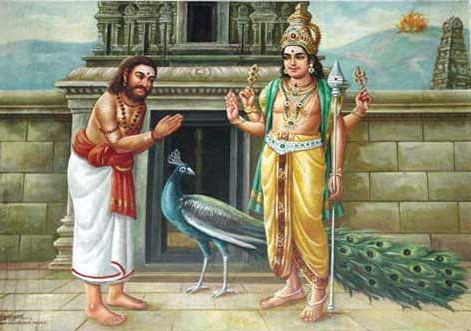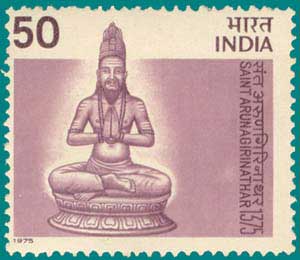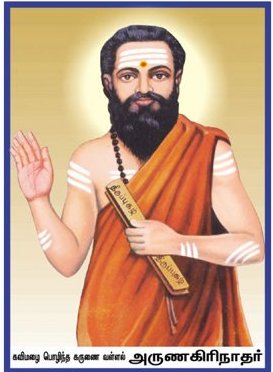அருணகிரிநாதர் என்றாலேயே அவர் அருளிச் செய்த திருப்புகழ், கந்தரனுபூதி, கந்தரலங்காரம்முதலிய அற்புத பிரபந்தங்கள் கருத்தில் வரும். அவற்றின் வழியாகப் பிரவாகிக்கும் திருமுருகன் திருவருள் கருத்தை நிறைவிக்கும். இத்தகு அருளாளரின் வரலாறு மட்டும் மிகவும் குழப்பமானதாயும், தெளிவற்றதாயும் இருக்கிறது. இதை விட அவலம் யாதென்றால் தேவையற்றதும் வீணானதுமான இந்து தத்துவார்த்தங்களுக்கு முரணான அபவாதங்களும் அருணகிரியாரின் பெயரில் திணிக்கப் பட்டிருக்கிறமையையும் பார்க்கிறோம்.
அருணகிரிநாதரின் காலமாக எதனைத் தீர்மானிக்கலாம் என்பது குறித்தும் பல்வேறு அறிஞர்களிடையே கருத்துப் பேதமுண்டு. ஆனால் திருப்புகழில் கந்தபுராண அரங்கேற்றம் பற்றிய செய்தி இருக்கிறது.
முற்பட்ட இலக்கண நூலிடை,
தப்புற்ற கவிக்கெனவே அவை,
முற்பட்டு புதுத்துறை மாறிய புலவோனே
தப்புற்ற கவிக்கெனவே அவை,
முற்பட்டு புதுத்துறை மாறிய புலவோனே
இதன் மூலம் அருணகிரியார் கந்தபுராணம் அருளிய கச்சியப்ப சிவாச்சார்யாருக்கு பின் வந்தவர் என்று கருதலாம். அது போலவே, அருணகிரியார் காளமேகப்புலவரையும் ஓரிரு திருப்புகழ்களில் சிறப்பித்திருப்பதால் அவருக்கு பின் வந்தவர் அல்லது அவர் காலத்தவராயிருக்க வேண்டும். ஆனாலும் இவைகளை விடச் சிறப்பாக, 15ம் நூற்றாண்டின் பிற்பகுதியில் வாழ்ந்தவனான பிரபுடதேவ மகாராஜனைப் பற்றி இவர் பேசுவதால் அவன் காலத்தவர் என்று கருதலாம்.
‘அதல சேதனாராட’ என்ற திருப்புகழில் அருணகிரிநாதர் ‘உதய தாம மார்பான பிரபுடதேவமாராஜன் உளமுமாட வாழ்தேவர் பெருமாளே’ என்று அது அமைந்திருக்கிறது. ஆக, அருணகிரியார் காலம் 15ம் நூற்றாண்டிற்குரியது. அவர் காலத்தில் இலங்கையில் முருக வழிபாடு சிறப்புற்றிருந்திருக்கிறது. அவர் இலங்கையிலுள்ள யாழ்ப்பாணம், கதிர்காமம், திருகோணமலை, கந்தவனம் முதலிய தலங்களைப் பாடியிருப்பதால் இது புலனாகும். ஆகவே அவர் போர்த்துக்கீசியர் இந்தியா- இலங்கையில் தமது ஆட்சியை நிறுவ முன் பிறந்தவர் என்பதும் தெளிவு. ஆக, அவர் காலம் 15ம் நூற்றாண்டே.
அருணகிரிநாதருக்கு முற்பிறவி என்று கூட ஒரு கதை இருக்கிறது. அதுவும் பரவலாக வழங்கி வருகிறது. அது இவ்வாறு உள்ளது. அகத்திய மாமுனிவர் வளர்த்து வந்த நாய் ஒன்று தேவேந்திரனாக மாறியதாம். அது பிறகு அர்ஜூனனாகியதாம். பின்பு அதுவே கண்ணப்ப நாயனாராக பிறவி எடுத்ததாம். பிறகும் அது நக்கீரராயும் பிறவி எடுத்து கடைசியாக அருணகிரிநாதராயும் பிறந்ததாம். இந்தக் கதையை தண்டபாணி சுவாமிகள் என்கிற முருகபக்தர் தாம் இயற்றிய அருணகிரிநாதர் புராணத்திலும் எழுதியிருப்பதாகத் தெரிகிறது.
இது மிக முரணானது. மகாபாரதத்தில் பகவான் ஸ்ரீ கிருஷ்ணனால் கீதோபதேசம் அருளப்பட்டவனான பார்த்தனாகிய அர்ஜூனன் மீண்டும் பிறந்தான் என்று கருதுவது இந்து சமய நம்பிக்கைக்கே முரண். அது போல பெரிய புராணத்திலும் ஸ்ரீ ஆதி சங்கர பகவத் பாதாச்சார்யராலும் இன்னும் மாணிக்கவாசகர் முதலிய அருளாளர்களாலும் முக்தி நிலை பெற்றவர் என்றே துணிந்து கூறப்பட்ட புனிதரான கண்ணப்பதேவர் மீண்டும் பிறந்தார் என்கிறதும் சைவ சித்தாந்த மரபிற்கும் அவர் தம் பெருமைக்கும் இழுக்காகும். நக்கீரர் என்பது பற்றிச் சொல்ல வேண்டியதே இல்லை. அது இன்னும் பெருங்குழப்பங்களுக்கே வழி செய்யும்.
ஆக, இது போலவே அருணகிரிநாதருடைய வாழ்க்கை வரலாறு கட்டமைக்கப்பட்டிருக்கிற வேதனையான நிலையைக் காண்கிறோம். இது போலத்தான் பட்டினத்தார் என்ற துறவற சீலருக்கும் உருத்திரகணிகை ஒருவருக்கும் சிவாலயம் ஒன்றில் உண்டான (கள்ள) தொடர்பால் அருணகிரியார் பிறந்தார் என்றும் இப்புராணம் சொல்கிறது. இதுவும் மேற்படி தண்டபாணியடிகள் பெற்ற கனவில் சொல்லப்பட்ட செய்தி தானாம். இது எவ்வளவு கேவலம்? வீணே இருந்த பட்டினத்தடிகள் இங்கு கொண்டு வந்து சேர்த்த விபரீதத்தை என் சொல்ல..? அது போக.. அருணகிரிநாதர் காலம் என்ன? பட்டினத்தார் காலம் என்ன?
அருணகிரியாரும் தம் திருப்புகழ் ஒன்றில்
குடி வாழ்க்கை அன்னை மனையாட்டி பிள்ளை,
குயில் போற் பிரசன்ன மொழியார்கள்,
குலம் வாய்த்த நல்ல தனம் வாய்த்ததென்ன,
குரு வார்த்தை தன்னை உணராமல்…
குயில் போற் பிரசன்ன மொழியார்கள்,
குலம் வாய்த்த நல்ல தனம் வாய்த்ததென்ன,
குரு வார்த்தை தன்னை உணராமல்…
என்று பாடுவதனூடாக அவர் நற்குடிப்பிறப்புடையார் என்றும் அறியலாம். ஆக, மேற்கூறிய செய்தி மிக மோசமான கட்டுக்கதை எனலாம். இதற்குப் பிறகு வருகிற பிரச்சினை அவர் எந்தக் குலத்தைச் சேர்ந்தவர் என்பது.. இது நமக்கு அவ்வளவு அவசியமல்ல. இறையுணர்வு பெற்ற அருளாளர்கள் எக்குலத்தில் பிறந்தாலும் அவர் தம் இறையுணர்வையே போற்றிட வேண்டும். ஆனால் அவர் பிராமணர் என்றோ அல்லது தாழ்ந்த குலத்தைச் சேர்ந்தவர் என்றோ கருதுவதற்கும் இடமில்லை.
எப்படியோ, அருணகிரிநாதர் நல்ல கட்டமைப்பு மிக்க குடும்பத்தில் பிறந்தவர் என்பது ஒன்றே நாம் கண்டு கொள்ளக்கூடியதாகும். இதை விட ஒரு சிலர் கன்னிகையான முத்தம்மை என்ற கன்னிகைக்கு இறையருளால் ஆண் தொடர்பின்றி (யேசு கிறிஸ்து போல ?!?) அருணகிரியார் பிறந்தார் என்றும் சொல்லுகிறார்கள். இதுவும் இங்கு ஏற்பதற்குரியதாகவில்லை.
நாம் முன் சொன்ன அருணகிரிநாதர் புராணத்தில் அருணகிரிநாதரின் ஜன்மதினமாக புரட்டாதி உத்தரமும் தனுர் லக்னமும் செவ்வாய்க்கிழமையும் கூடிய நாள் என்று கூறப்பட்டிருக்கிறது. ஆனிப் பூரணையையும் அருணகிரிநாதர் விழாவாக இலங்கையில் சில அன்பர்கள் கொண்டாடி வருகிறார்கள். உண்மை எதுவென்று தெளிய இயலாதிருக்கிறது. எது எவ்வாறாகிலும் தமிழ்ச் சந்தக் கவியாகிய அருணகிரிநாதருக்கு எல்லோரும் ஒன்றுபட்டு, ஒரு நாளில் முக்கியமாக முருக பக்தர்கள் பக்தி விழாவும் இசை ஆர்வலர்கள் தியாகராஜ சுவாமிகளுக்குச் செய்வது போல இசை விழாவும் எடுப்பது அவசியமாகும்.
இது போலவே. அருணமுனிவர் பற்றி இன்னும் பல செய்திகளும் வழங்கி வருகின்றன. அவர் தம் திருப்புகழில் நிறைய சம்ஸ்கிருதச் சொற்களைப் பயன்படுத்துவதைக் கண்டு அவர் பிராமணர் என்று சொல்பவர்களும் இருக்கிறார்கள். இது சிறிதும் ஆதாரமற்றது. அவர் எங்கும் தான் அந்தண மரபினர் என்று சொன்னதாகவே தெரியவில்லை. அது தவிர, சிலர் சம்ஸ்கிருதத்தில் பாகவதசம்பு, சாளுவாப்யுதயம் முதலிய நூல்கள் எழுதிய சோணாத்ரிநாதரும் இவரும் ஒன்று என்று கூட மயங்குகிறார்கள். இது உண்மையில் தவறு என்று ஆய்வாளர்கள் நிரூபித்திருக்கிறார்கள்.
எவ்வாறாகிலும் அருணகிரிநாதர் திருவண்ணாமலையில் பிறந்தவர் என்று சொல்வதை ஏற்றுக்கொள்ளலாம். அத்துடன் அவருக்கு திருவண்ணாமலையுடன் தன் வாழ்வில் நெருக்கமான தொடர்பு இருந்திருப்பதையும் அவதானிக்கக் கூடியதாக உள்ளது. இப்படிப்பட்ட பெருமகனார் தம் திருப்புகழில் ஓரிடத்தில் கூட கிரிவலம் பேசாமையும் ஈண்டு சிந்திக்கத் தக்கது.
எவ்வாறானாலும் அருணகிரிநாதர் தமது இளமைப்பருவத்தில் கீழான நடத்தையில் ஈடுபட்டார் என்கிற கருத்தை ஏற்காமல் இருக்க இயலாது. இதைத் திருமுருக கிருபானந்த வாரியார் சுவாமிகள் போன்ற பெருமக்களும் அங்கீகரித்திருப்பதால் அதை நாமும் ஏற்கலாம். முக்கியமாக, திருப்புகழ் பாடல்களில் பல்வேறு இடங்களிலும் பெண்கள் பற்றியும் பெண்களால் தாம் பட்ட அவலங்கள் பற்றியும் ஒழுக்கம் கெட்டவர்களாக ஆண்களை மயக்கும் பெண்களின் அவயவங்கள் மற்றும் அவர்களின் நடத்தைகள் பற்றியும் பலவாறாகப் பேசுவதால் அவர் பெண்கள் மீது தீராத காமம் கொண்டு அலைந்தார் என்று கருதுவது தவறில்லை என்றே தோன்றும். உதாரணமாக,
மானார் கனி வாய் உகந்து சிக்கெனவே அணைந்து
கைப்பொருளே இழந்து அயர்வாயே
கைப்பொருளே இழந்து அயர்வாயே
இவ்வாறு ஏராளமான திருப்புகழ்களைப் பார்க்கலாம். அத்தோடு இவர் இக்காலத்தில் கடவுள் இல்லை என்று நாத்தீகம் பேசினார் என்பதையும், மது மாது மாமிசம் போன்ற தொடர்புகளையும் ஏற்படுத்திக் கொண்டார் என்றும் தெரிகிறது.
ஆனால், இவ்வாறான கேவலமான வாழ்வில் தனது பொருள், இளமை, அழகு, அறிவு எல்லாவற்றையும் பறி கொடுத்த நிலையில் வாழ்வில் விரக்தியுற்று தான் பிறந்து, வளர்ந்து வாழும் ஊராகிய திருவண்ணாமலைக் கோபுரத்தில் ஏறி தற்கொலைக்கு முயன்றார் என்பதையும் நம்புவதற்கு அகச்சான்றுகள் கிடைக்கின்றன. பாம்பன் சுவாமிகள் முதலிய எல்லா பெரியவர்களும் இதனை ஆமோதிப்பதாகவே தெரிகிறது.
ஆனால், இவ்வாறான கேவலமான வாழ்வில் தனது பொருள், இளமை, அழகு, அறிவு எல்லாவற்றையும் பறி கொடுத்த நிலையில் வாழ்வில் விரக்தியுற்று தான் பிறந்து, வளர்ந்து வாழும் ஊராகிய திருவண்ணாமலைக் கோபுரத்தில் ஏறி தற்கொலைக்கு முயன்றார் என்பதையும் நம்புவதற்கு அகச்சான்றுகள் கிடைக்கின்றன. பாம்பன் சுவாமிகள் முதலிய எல்லா பெரியவர்களும் இதனை ஆமோதிப்பதாகவே தெரிகிறது.

அருணகிரிநாதர் திருமணம் செய்து இல்லற வாழ்வில் ஈடுபட்டவர் என்றும் கூறுவர். இதற்கும் திருப்புகழ்களில் ஆதாரம் காட்டுவர். இதை நம்மால் ஏற்கவும் மறுக்கவும் முடியவில்லை. ஆனால் அருணை முனிவர் துறவியாகவே இருந்திருக்க வேண்டும் என்று கருதுவதற்கு இல்லை. அவர் சுந்தரமூர்த்தி சுவாமிகள் போல, சேரமான் பெருமாள் போல, பெரியாழ்வார் போல, இன்னும் எத்தனையோ பெரியவர்கள் போல பிற்காலத்தில் சீரான- சிறந்த இல்லறம் பேணியிருக்கலாம்.
எனவே, தற்கொலைக்கு முயன்ற அருணகிரியை அருளாளனான முருகவேள் தன் திருக்கரத்தால் ஏந்தி காப்பாற்றினார். தமது திருக்கரத்தில் விளங்கும் ஞானவேலால் அவர் நாவில் எழுதி ஆசீர்வதித்தார். இந்நிகழ்வை ஏற்பதற்கும் முருகன் அருணகிரிக்கு உபதேசித்தார் என்பதற்கும் தக்க சான்றுகள் நிறையவே உண்டு.
அருணைநகர் மிசை கருணையோடருளிய மௌன வாசமும் இருபெரும் சரணமும் மறவேனே
என்றும் இன்னும் பிறவாயும் இவ்வாறு முருகன் அருளியதை அருணகிரியார் வியந்து பாடியிருக்கிறார். மேலும் கந்தரனுபூதியில்
‘சும்மா இருசொல்லற என்றலுமே அம்மா பொருளொன்றும் அறிந்திலனே’
‘சும்மா இருசொல்லற என்றலுமே அம்மா பொருளொன்றும் அறிந்திலனே’
என்று பாடுவதனூடும், திருமுருகன் அருணகிரிக்கு ஜெபமாலை அருளியதாகவும் தெரிகிறது. அதை ‘செபமாலை தந்த சற்குருநாதா’ என்ற திருப்புகழ் வரி காட்டி நிற்கிறது. இது போல அருணகிரியாருக்கு வயலூரிலும் விராலிமலையிலும் அற்புத தரிசனங்கள் கிடைத்திருக்கின்றன.
இது போலவே சிதம்பரத்திலும் திருச்செந்தூரிலும் பெருமான் நிருத்த தரிசனம் காட்டியதாகவும் அருணகிரியார் பாடியிருக்கிறார்.
கொண்டநட னம்பதம் செந்திலிலும் என்றன்முன்
கொஞ்சிநட னங்கொளுங் கந்தவேளே
வில்லிபுத்தூரர் என்பவருடன் அருணகிரி வாதம் செய்து வென்றார் என்றும் கூறுவர். இதன் பின் வில்லிபுத்தூரர் செய்த தவறை மன்னித்து அவருக்கு மேலான கருணை செய்தார் என்றும் வரலாறு உள்ளது. இதை வைத்தே ‘கருணைக்கு அருணகிரி’ என்ற பழமொழி உருவாகியிருக்கிறது. இது போலவே பிரபுடதேவராஜனுக்காக அருணகிரிநாதர் முருகதரிசனம் காட்டினார் என்கிற வரலாறும் உண்டு. இதற்கும் திருப்புகழ்களில் நிறைவான சான்றுகள் உள்ளன.
கொஞ்சிநட னங்கொளுங் கந்தவேளே
வில்லிபுத்தூரர் என்பவருடன் அருணகிரி வாதம் செய்து வென்றார் என்றும் கூறுவர். இதன் பின் வில்லிபுத்தூரர் செய்த தவறை மன்னித்து அவருக்கு மேலான கருணை செய்தார் என்றும் வரலாறு உள்ளது. இதை வைத்தே ‘கருணைக்கு அருணகிரி’ என்ற பழமொழி உருவாகியிருக்கிறது. இது போலவே பிரபுடதேவராஜனுக்காக அருணகிரிநாதர் முருகதரிசனம் காட்டினார் என்கிற வரலாறும் உண்டு. இதற்கும் திருப்புகழ்களில் நிறைவான சான்றுகள் உள்ளன.
அது போலவே, இன்றைக்கு திருவண்ணாமலைக் கோயிலுக்குள் வாயிலை ஒட்டியே‘கம்பத்து இளையனார் சந்நதி’ என்ற அழகிய சிறிய முருகன் ஆலயத்தைப் பார்க்கலாம். இவ்விடத்திலேயே அருணகிரிநாதருடைய வேண்டு கோளின் படி பிரபுடதேவமாராசனுக்கு கந்தப்பெருமான் கம்பத்தில் (தூணில்) தோன்றி காட்சி கொடுத்ததாக ஐதீகம்.
அதல சேடனாராட அகில மேரு மீதாட
அபின காளி தானாட அவளோடன்று
அதிர வீசி வாதாடும் விடையிலேறுவாராட
அறுகு பூத வேதாளம் அவையாட
அபின காளி தானாட அவளோடன்று
அதிர வீசி வாதாடும் விடையிலேறுவாராட
அறுகு பூத வேதாளம் அவையாட
மதுரவாணி தானாட மலரில் வேதனாராட
மருவு வானுளோராட மதியாட
வனசமாமியாராட நெடிய மாமனாராட
மயிலுமாடி நீயாடி வரவேணும்
மருவு வானுளோராட மதியாட
வனசமாமியாராட நெடிய மாமனாராட
மயிலுமாடி நீயாடி வரவேணும்
கதைவிடாத தோள் வீமன் எதிர்கொள் வாளியால் நீடு
கருதலார்கள் மாசேனை பொடியாக
கதறு காலிபோய் மீள விஜயனேறு தேர் மீது
கனக வேத கோடூதி அலை மோதும்
கருதலார்கள் மாசேனை பொடியாக
கதறு காலிபோய் மீள விஜயனேறு தேர் மீது
கனக வேத கோடூதி அலை மோதும்
உததி மீதிலே சாயும் உலகமூடு சீபாத
உவணமூர்தி மாமாயன் மருகோனே
உதயதாம மார்பார்பி ரபுடதேவமாராஜன்
உளமுமாட வாழ்தேவர் பெருமாளே
உவணமூர்தி மாமாயன் மருகோனே
உதயதாம மார்பார்பி ரபுடதேவமாராஜன்
உளமுமாட வாழ்தேவர் பெருமாளே
என்பது அப்போது அவர் பாடிய அற்புதப் பாடல். இப்பாடலைப் போலவே அவர் அருளிய அனைத்துத் திருப்புகழ்களும் சந்தம் நிறைந்து சிந்தை கவரும் சுந்தர மந்திரப் பெட்டகங்களாக விளங்குகின்றன.
 இனி அருணகிரியார் கிளியுருக் கொண்டு விண்ணுலகம் சென்று கற்பக மலர் கொண்டு வந்தார் என்றும் அதன் பின் அப்படியே கிளி வடிவாக திருத்தணிகைக்குச் சென்று முருகன் தோளில் அமர்ந்து ‘கந்தரனுபூதி’ பாடினார் என்றும் சொல்லப்படும் செய்திகளுக்கெல்லாம் ஆதாரம் இருப்பதாகத் தெரியவில்லை.
இனி அருணகிரியார் கிளியுருக் கொண்டு விண்ணுலகம் சென்று கற்பக மலர் கொண்டு வந்தார் என்றும் அதன் பின் அப்படியே கிளி வடிவாக திருத்தணிகைக்குச் சென்று முருகன் தோளில் அமர்ந்து ‘கந்தரனுபூதி’ பாடினார் என்றும் சொல்லப்படும் செய்திகளுக்கெல்லாம் ஆதாரம் இருப்பதாகத் தெரியவில்லை.
ஆனாலும் கந்தரனுபூதி அவரது ஞானமுதிர்ச்சியில் பாடியது என்பது தெளிவாக அப்பாடல்களின் ஊடாகத் தெரிய வருகிறது.
அருணகிரியார் மிகுந்த தமிழ்ப் பற்றுடையவராயும் இருந்திருக்கிறார். அதற்கு அவர் ‘முந்து தமிழ் மாலை’ என்று சொல்வதே சான்று. எத்தனை மொழியிருப்பினும் அவற்றுள் முந்தி நிற்பதால் அருணகிரியார் தமிழுக்கு கொடுத்த சிறப்பு அடைமொழியோடு கூடிய பெயர் முந்து தமிழ். அருணகிரிநாதரது திருப்புகழ்களும் மற்றும் பிரபந்தங்களையும் ஆராய்ந்து கற்பது அவசியம். அவற்றில் அக்கால வழக்கங்கள் பலவும் கூட இடம்பெற்றிருக்கின்றன.
இராமாயணம் முழுவதையும் அருணகிரியார் திருப்புகழ்களில் பல இடங்களில் விரவிப் பாடியிருக்கிறார். கிருஷ்ண லீலைகளும் பாடியிருக்கிறார். சுந்தரர், திருஞானசம்பந்தர் முதலிய பெருமக்கள் பற்றியும் பாடியிருக்கிறார். அருணகிரிநாதப் பெருமான் பாடிய பிரபந்தங்கள் யாவற்றையும் இக்கட்டுரையில் அலசின் கட்டுரை மிக விரியும். ஆக, அருணகிரிநாதப் பெருமானின் சிறப்புகள் தெளிவாகப் புரிந்து கொள்ளப்பட வேண்டுமாயில் அறிஞர்கள் இவ்வரலாற்றில் ஆங்காங்கே முளைத்து விட்ட களைகள் நீக்கி, உண்மையை உலகறியச் செய்ய வேண்டிய கடப்பாடுடையவர்களாகிறார்கள்.
‘எல்லாரும் ஞானத் தெளிஞரே கேளீர் சொல்
கல்லெல்லாம் மாணிக்கக் கல்லாமோ- பொல்லாக்
கருப்புகழைக் கேட்குமோ கானமயில் வீரன்
திருப்புகழைக் கேட்கும் செவி’
கல்லெல்லாம் மாணிக்கக் கல்லாமோ- பொல்லாக்
கருப்புகழைக் கேட்குமோ கானமயில் வீரன்
திருப்புகழைக் கேட்கும் செவி’
(ஒரு வெண்பா)
அருணகிரிநாதர் நூல்கள் மொத்தம் 9. அவை :
- கந்தர் அந்தாதி (Kanthar Anthathi)
- கந்தர் அலங்காரம் (Kanthar Alankaram)
- கந்தர் அனுபூதி (Kanthar Anupoothi)
- சேவல் விருத்தம் (Seval Virutham)
- திருஎழுகூற்றிருக்கை (Thiruvezhukoorrirukkai)
- திருப்புகழ் (Thiruppugazh)
- திருவகுப்பு (Thiruvaguppu)
- மயில் விருத்தம் (Mayil Virutham)
- வேல் விருத்தம் (Vel Virutham)


.jpg)

.jpg)


.jpg)
.jpg)
.jpg)

.jpg)
.jpg)
.jpg)



















